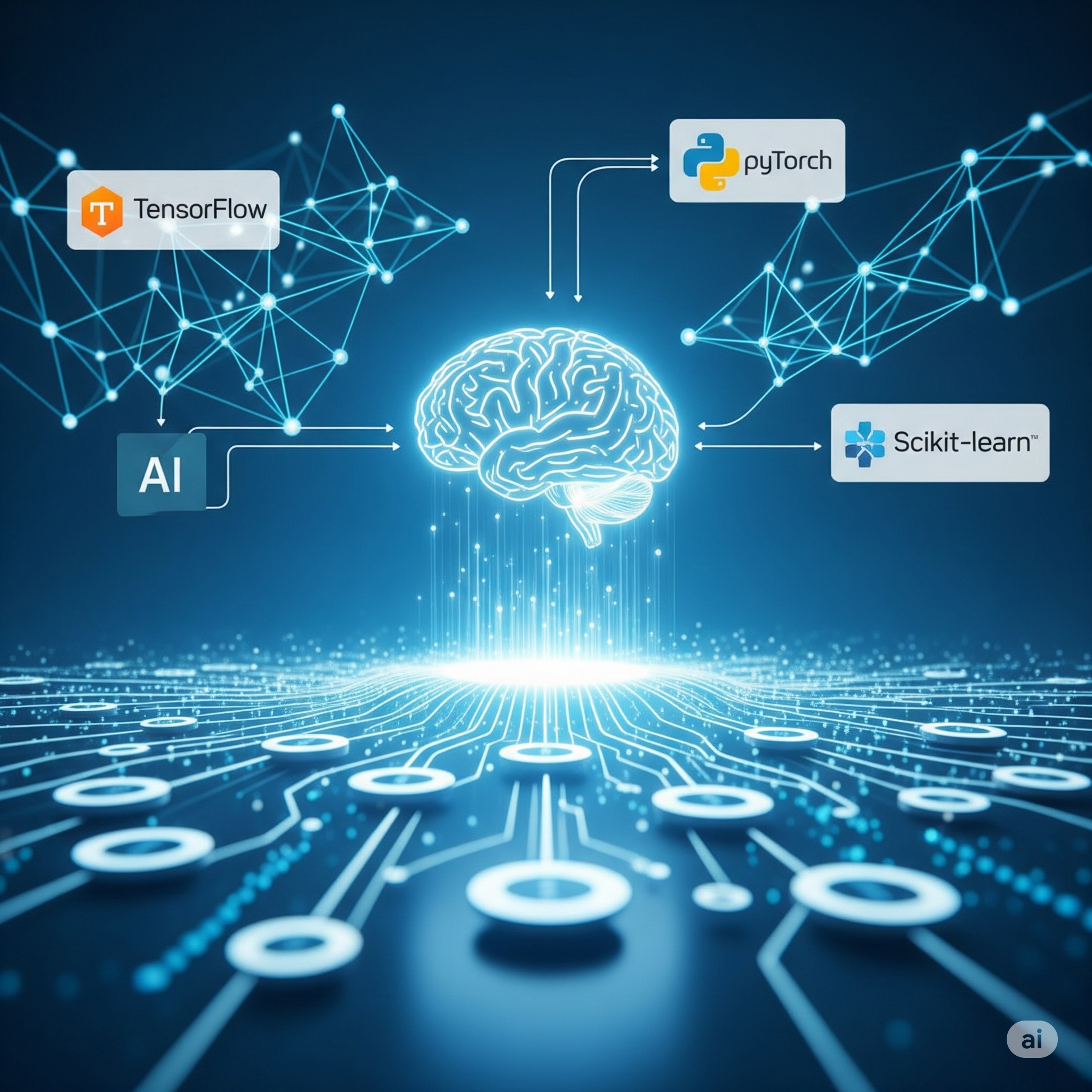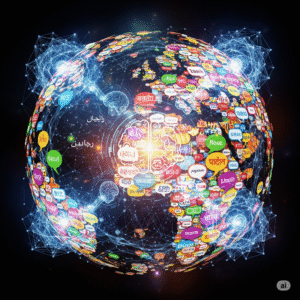In a world buzzing with AI, businesses face a critical choice: adopt generic, off-the-shelf AI tools or build something uniquely powerful? While pre-packaged solutions offer convenience, they often lack the flexibility and competitive edge your business needs to truly thrive. This is where the game changes. Enter the world of open-source AI frameworks—the powerful, transparent, and cost-effective foundation for creating truly custom AI solutions.
Forget the black-box approach. Building with open-source tools puts you in the driver’s seat, allowing you to tailor AI capabilities to your specific data, challenges, and goals. This guide is your roadmap. We’ll demystify these frameworks, showcase their real-world power, and provide a clear path for you to start leveraging them. By the end, you’ll understand how to transform your raw data into your most valuable asset, driving smarter decisions and creating a formidable competitive advantage.
What Exactly Are Open-Source AI Frameworks?
Let’s break it down. An “AI framework” is a library or collection of pre-written code, tools, and components that developers use as a foundation to build AI and machine learning models. Instead of starting from scratch, they get a robust toolkit. The “open-source” part means the underlying source code is publicly available, free to use, modify, and distribute. Think of it as a community-built, professional-grade kitchen stocked with every high-end appliance you could need to cook a gourmet meal, rather than buying a pre-made microwave dinner.
This accessibility has fueled an explosion of innovation. A global community of developers and researchers—from giants like Google and Meta to academics and independent coders—continuously improves these tools. This collaborative spirit ensures that open-source AI frameworks are not just free; they are often more advanced, secure, and flexible than their expensive, proprietary counterparts. They give you the power to look “under the hood,” understand exactly how your AI works, and customize it without limitation.
Why Choose Open-Source AI Frameworks Over Proprietary Solutions?
The decision to build a custom AI solution is strategic, and choosing an open-source path offers compelling advantages that directly impact your bottom line and your capacity for innovation. When you move beyond the one-size-fits-all model, you unlock a new tier of business intelligence that is specifically tuned to your operational DNA.
Here are the key benefits of embracing open-source AI frameworks:
- Unmatched Flexibility and Customization: Proprietary software locks you into the vendor’s vision. Open-source frameworks give you complete control. You can tweak algorithms, integrate with any system, and build features that solve your unique problems—not the problems a vendor thinks you have.
- Significant Cost Savings: Licensing fees for enterprise-grade AI software can be astronomical. Open-source frameworks are free to use, eliminating a major barrier to entry. Your investment shifts from expensive licenses to hiring or training the talent who will build your solutions, a far more valuable long-term asset.
- Transparency and Trust: With proprietary AI, you often don’t know the exact logic behind its decisions. This “black box” problem can be a major risk. Open-source code is transparent. You can audit it, understand its biases, and ensure it aligns with your company’s ethical standards and regulatory requirements.
- Vibrant Community Support: Stuck on a problem? With popular frameworks like TensorFlow or PyTorch, there’s a massive global community of experts on forums, GitHub, and Stack Overflow ready to help. This collective knowledge base is often faster and more comprehensive than a single company’s customer support.
- Future-Proofing Your Technology: Technology moves fast. Relying on a single vendor can be risky if they fall behind, get acquired, or discontinue a product. Open-source ecosystems are dynamic and constantly evolving, ensuring your tech stack remains modern and robust. As OpenAI demonstrates, rapid, community-driven development is the future.
Top Open-Source AI Frameworks You Should Know in 2025
Navigating the landscape of open-source AI frameworks can seem daunting, but a few key players dominate the field. Understanding their strengths will help you choose the right tool for the job.
H3: TensorFlow: The Industry Titan for Scalable Machine Learning
Developed by Google, TensorFlow is an end-to-end platform for building and deploying machine learning models. It’s renowned for its scalability, making it ideal for large-scale production environments. Its ecosystem includes tools like TensorBoard for visualization and TensorFlow Lite for deploying models on mobile and IoT devices. It’s the framework behind many Google products, from Search to Photos.
H3: PyTorch: The Researcher’s Favorite for Flexibility
Created by Meta AI, PyTorch has gained immense popularity, especially in the research community, for its simplicity and Python-first approach. It offers a more imperative (step-by-step) programming style that feels natural to developers, making it excellent for rapid prototyping and complex, dynamic neural networks. Its “define-by-run” philosophy makes debugging far more intuitive.
H3: Scikit-learn: The Go-To for Classic Machine Learning
For tasks that don’t require the complexity of deep learning, Scikit-learn is the undisputed champion. It provides simple and efficient tools for data mining and data analysis. If your business needs involve classification, regression, clustering, or dimensionality reduction—like segmenting customers or predicting sales—Scikit-learn is often the fastest and most effective starting point.
H3: Keras: The User-Friendly Gateway to Deep Learning
Keras is a high-level API that can run on top of other frameworks like TensorFlow. Its primary design principle is user-friendliness and rapid experimentation. Keras allows you to build a sophisticated deep learning model in just a few lines of code, making it an excellent choice for teams that are new to AI development or need to iterate on ideas quickly.
Real-World Success: How Businesses Leverage Open-Source AI Frameworks
Theory is great, but results are what matter. Let’s look at how businesses are using these tools to create powerful custom AI solutions that drive real value.
Case Study 1: E-commerce Personalization at Stitch Fix
Stitch Fix, the online personal styling service, has built its entire business model on a foundation of data science and custom AI. They use a variety of tools, but their approach perfectly embodies the principles of using open-source AI frameworks. Their algorithms, which handle everything from inventory management to personalized clothing recommendations, are custom-built to understand the nuances of fashion and individual taste.
- Problem: Generic recommendation engines (“people who bought this also bought…”) are ineffective for fashion, which is deeply personal.
- Solution: Stitch Fix developed a suite of custom algorithms using open-source tools. These models analyze over 85 data points for each item of clothing and combine that with detailed client feedback, style quizzes, and even Pinterest boards.
- Outcome: This hyper-personalized experience drives incredible customer loyalty and a highly efficient inventory system. They created a unique competitive moat that off-the-shelf software could never provide.
Case Study 2: Predictive Maintenance at a Major Airline
Airlines operate on razor-thin margins, and unscheduled maintenance is a massive source of cost and disruption. One major airline turned to a custom AI solution to tackle this head-on.
- Problem: Predicting when an aircraft component might fail is incredibly complex, involving thousands of sensors and historical data points. Standard maintenance schedules are often inefficient.
- Solution: Using an open-source framework like TensorFlow, their data science team built a predictive maintenance model. The model ingests real-time sensor data from aircraft engines, along with historical maintenance logs and flight data. It learns to identify subtle patterns that precede a component failure.
- Outcome: The system now flags parts for inspection before they fail, allowing for scheduled maintenance during planned downtime. This has drastically reduced flight cancellations, saved millions in operational costs, and improved overall fleet safety.
Your Roadmap: A Beginner-Friendly Workflow for Implementing Custom AI Solutions
Ready to start your journey? Building your first custom AI solution is a structured process. Here’s a simplified workflow perfect for getting started.
- Define a Clear Business Problem: Don’t start with “we need AI.” Start with a specific, high-value problem. Is it high customer churn? Inefficient inventory? Poor marketing ROI? A well-defined problem is the most critical first step.
- Data Collection and Preparation: AI models are only as good as the data they’re trained on. Identify, gather, and clean the relevant data. This is often the most time-consuming step but is absolutely essential.
- Choose the Right Open-Source AI Framework: Based on your problem, select your tool. For traditional analytics and prediction, start with Scikit-learn. For complex image recognition or NLP, consider PyTorch or TensorFlow with Keras.
- Model Development and Training: This is where your data scientists or developers write the code to build and train the model. They’ll experiment with different algorithms and parameters to find the one that best solves your problem.
- Deployment and Integration: A model isn’t useful until it’s integrated into your business processes. This could mean feeding its predictions into your CRM, an internal dashboard, or your e-commerce website.
- Monitor and Iterate: The world changes, and so does your data. Continuously monitor your model’s performance to ensure it remains accurate and effective. Be prepared to retrain and update it over time. As noted in a McKinsey report, continuous iteration is key to long-term success.
Essential AI Tools to Complement Your Open-Source AI Frameworks
Building a model is one thing; making its insights accessible to your team is another. These tools work hand-in-hand with your custom-built models.
- Tableau / Power BI: These are leading business intelligence and data visualization platforms. You can feed the outputs of your custom AI models into Tableau or Microsoft Power BI to create interactive dashboards that allow non-technical team members to explore the data and gain insights.
- MonkeyLearn: If your custom solution involves text analysis (like sorting customer feedback), a tool like MonkeyLearn can offer pre-built models and a user-friendly interface that can complement your core development on an open-source framework.
- ChatGPT / Generative AI: Beyond its popular use as a chatbot, tools like ChatGPT are invaluable for developers. They can help debug code, write boilerplate functions, explain complex concepts, and accelerate the development process within your chosen open-source AI frameworks.
The Future is Custom: Why Open-Source AI is More Than Just a Trend
The initial wave of AI adoption was dominated by plug-and-play solutions. The next, more transformative wave will be defined by customization. Businesses that learn to harness open-source AI frameworks to build bespoke solutions will be the ones who lead their industries. They will operate more efficiently, understand their customers more deeply, and innovate more quickly than their competitors.
This isn’t about replacing human intuition; it’s about augmenting it with data-driven precision. It’s about building technological assets that are uniquely yours, perfectly aligned with your vision, and impossible for others to replicate. The tools are available, the community is there to support you, and the potential for growth is immense. The only remaining question is: what will you build?
the Best AI Assistant: A Comprehensive Guide for Professionals
Top 10 Generative AI Tools for Professional Content Creation



